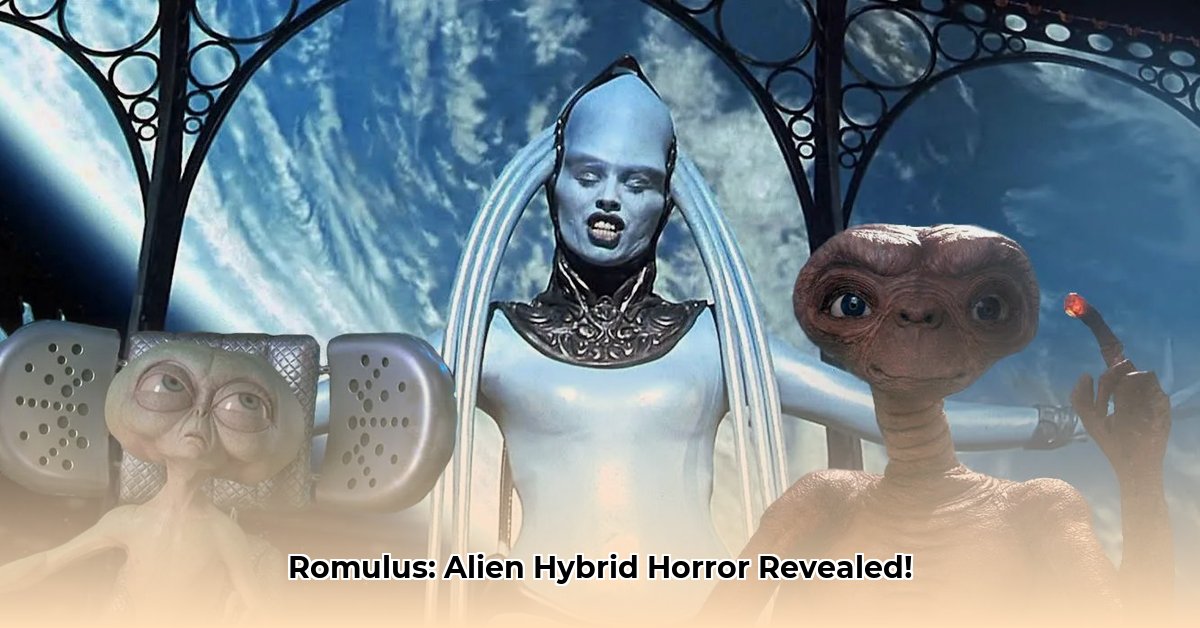Ever wondered what happens when corporate greed meets terrifying alien evolution? Alien: Romulus throws you headfirst into that nightmare. This isn’t just another monster movie; it’s a twisted tale of human ambition, synthetic life, and the ever-evolving Xenomorph, all playing out in the already-creepy world of the Alien films. We’ll break down everything – the shocking ending people are arguing about, the deeper meanings hidden in the plot, and how this movie might change the future of the Alien franchise. So buckle up, whether you’re a long-time fan or just curious, because we’re diving into the heart of the horror in Alien: Romulus. Get ready for some seriously unsettling details!
Unveiling the Hybrid Horror in Alien: Romulus
Get ready for a wild ride because Alien: Romulus isn’t your typical space horror flick. It throws everything at the wall and somehow, most of it sticks. Think classic Alien DNA spliced with some seriously twisted new ideas, resulting in a film that’s both familiar and utterly terrifying. This isn’t a simple rehash; it’s a bold experiment, and we’ll dive deep into the good, the bad, and the downright horrifying.
A Gruesome Story of Survival
The movie plunges you into chaos. A group of young space colonizers, seeking a better life, stumble upon an abandoned space station. Their goal: to scavenge cryo-chambers for a journey to Yvaga III. But this derelict station holds a deadly secret: it’s infested with Xenomorphs, the result of Weyland-Yutani’s twisted experiments.
The abandoned station, Renaissance, is composed of two modules: Remus and Romulus. The crew soon discovers that the original team aboard Renaissance had recovered the original “Big Chap” Xenomorph from the 1979 Alien film. This Xenomorph, thought dead after being ejected into space by Ripley, was very much alive and spawned a new hive.
As the team delves deeper, they realize they’re not just fighting for survival against the Xenomorphs, but also against time, as the station is on a collision course with a nearby planet’s rings. The situation quickly deteriorates, forcing them to make impossible choices. Characters are brutally killed off one by one. Trust is shattered. All the while, the sinister shadow of the Weyland-Yutani Corporation looms large, their unethical experiments the root cause of the nightmare unfolding around them.
Prepare for familiar foes, but also some truly nightmarish additions to the Xenomorph family tree. Survival is the only objective, and the odds are astronomically against them. This is not a subtle horror; this is a visceral thrill ride that’ll leave your heart pounding. And yes, there are plenty of Alien Romulus spoilers ahead, so brace yourself.
Deeper Meanings: Beyond the Monsters
Alien: Romulus offers more than just cheap thrills; it dives into chilling themes. Corporate greed, a staple of the Alien franchise, returns with full force. Weyland-Yutani’s relentless pursuit of profit, regardless of the cost in human lives, drives the plot forward. The company’s recklessness unleashes unimaginable horror on the unsuspecting colonists.
The film also explores the terrifying adaptability of the Xenomorphs. They’re constantly evolving, taking on new and horrifying forms. This hints at a future far more frightening than anything seen before. The film explores the frightening potential of what happens when corporate greed collides with something beyond our control.
Moreover, Alien: Romulus delves into the ethics of artificial intelligence. Andy, an android integral to the team, grapples with conflicting directives. Programmed to protect Rain, he also receives instructions from the resurrected AI of Rook, the Renaissance’s science officer, to prioritize Weyland-Yutani’s objectives – the retrieval of Xenomorph specimens and data. This conflict highlights the dangers of unchecked corporate control over AI and the potential for synthetics to be exploited for nefarious purposes.
Imperfect Heroes: Flawed and Relatable
The characters in Romulus are realistically flawed. They aren’t heroic space marines, but ordinary people thrust into extraordinary circumstances. They grapple with fear, self-preservation, and the weight of their relationships. Sibling bonds, romantic tensions, and personal demons add layers of complexity to their struggles.
Amidst the gore and terror, you witness genuine courage, heartbreaking loss, and the raw fragility of humanity confronting cosmic horror. These relatable characters make the film’s scares all the more impactful. You’re not just watching monsters but witnessing ordinary people fighting for their lives. The film highlights the resilience of the human spirit in the face of unimaginable adversity.
A Visually Stunning Nightmare
Alien: Romulus is a visual masterpiece of dread. The filmmakers expertly use shadows, darkness, and claustrophobic sets to build an atmosphere of constant unease. It’s as if the shadows are another monster, creating a pervasive sense of dread.
The special effects are impressive. The Xenomorphs look appropriately terrifying, a far cry from cheesy sci-fi monsters. The sound design is equally effective. Every creak, slither, and guttural roar from the creature adds to the unrelenting tension, keeping you on the edge of your seat. The film leverages sound design to amplify the dread and unease. From the screeching of metal to the horrifying clicks and hisses of the Xenomorphs, sound becomes another layer of terror that permeates every scene.
The Divisive Ending: A Springboard for Debate
The ending of Alien: Romulus is bold, unexpected, and controversial. The internet is buzzing with debate. Some hail it as a brilliant, chilling glimpse into the Xenomorphs’ terrifying future, hinting at a new era of nightmare. Others find it an unsatisfying conclusion, leaving too many questions unanswered. Still others believe it perfectly highlights the devastating consequences of corporate arrogance.
The ambiguity sparks conversations, theories, and lasting impressions. The film’s final moments feature the birth of a human-Xenomorph hybrid, a creature born from Kay after she injects herself with Compound Z-01, a derivative of the black goo from Prometheus. This hybrid, with its long limbs and Xenomorph features, represents the horrifying culmination of Weyland-Yutani’s experiments. The fate of this creature, and of Rain and Andy as they enter cryosleep, is left unresolved. The film explicitly leaves the door open for sequels to explore the ramifications of the hybrid’s existence and the future of the protagonists.
Is it Worth Watching?
Alien: Romulus is a film that takes risks. It pushes boundaries, embraces ambiguity, and doesn’t shy away from unsettling imagery. It might not be perfect – some may find the pacing uneven or the horror elements too graphic – but its bold vision and commitment to its themes make it a worthwhile watch. The film’s success lies in creating a terrifying, memorable cinematic experience within the established Alien universe. Long after the credits roll it leaves you thinking.
Strengths and Weaknesses: A Balanced View
| Feature | Strengths | Weaknesses |
|---|---|---|
| Story | Intriguing premise, strong core themes, expands on established lore | Some plot points could be more developed, relies on familiar tropes |
| Characters | Relatable, complex motivations, diverse personalities | Some character arcs feel underdeveloped, certain character decisions questionable |
| Visuals/Sound | Stunning visuals, masterful soundscape, creates palpable tension | Graphic horror may be off-putting to some viewers |
| Ending | Bold, thought-provoking, sparks debate, sets up potential sequels | Divisive and potentially unsatisfying for viewers seeking clear resolution |
Ultimately, Alien: Romulus is a significant addition to the Alien saga, a film that will generate heated discussions and lasting impressions. The ending alone guarantees that Alien Romulus spoilers will be a hot topic for years to come. It’s a film you’ll likely either love or hate; there’s no middle ground. The legacy of this entry rests on how future films choose to address its audacious and somewhat divisive conclusion.
The Future of the Alien Franchise After Romulus
Key Takeaways:
- Alien: Romulus deepens the franchise’s lore by directly connecting to the Prometheus storyline through Compound Z-01, enhancing the exploration of Xenomorph creation and corporate experimentation.
- The film’s intentionally ambiguous ending, featuring a human-Xenomorph hybrid and the uncertain fates of the protagonists, establishes a fertile ground for thematic exploration in future sequels.
- By blending classic Alien elements with new narratives, the film offers a fresh perspective on corporate greed, synthetic life’s role, and Xenomorph evolution, potentially reshaping the trajectory of the franchise.
A Hybrid’s Birth: A New Era of Terror?
Alien: Romulus thrusts into a chilling narrative. Weyland-Yutani’s hubris drives the creation a human-Xenomorph hybrid through Compound Z-01. This creature born out of science gone wrong is a new benchmark for alien horror.
Endless Possibilities: Open Endings
The film’s conclusion is deliberately open-ended, leaving the fates of Rain and Andy in cryosleep uncertain. How does Alien Romulus ending impact future alien franchise sequels? The answer: it creates an ideal launching point. The fate of the hybrid and
- Unlock Your Potential with Adult Vocal Lessons at Any Age - January 8, 2026
- Adult Voice Lessons Transform Your Singing and Build Confidence - January 7, 2026
- Vocal Performance Artistry Requires Unmatched Control and Emotional Depth - January 6, 2026










